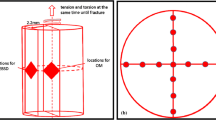Abstract
Power applications generate high stresses which can damage piezoceramic components. In this study tensile fracture of several types of PZT (hard/soft) is investigated. After validation of the specimen geometry by means of numerical simulation, samples are led to failure using a specific device. Weibull law parameters enable the characterisation of the tensile strength distribution and highlight clear differences between soft and hard ceramics. A fractographic approach emphasises the specificities of the fracture mode and the fracture origin for each type of samples.
Similar content being viewed by others
References
Blunt, L., Dong, W.P., Mainsah, E., Luo, N., Mathia, T., Stout, K.J., Sullivan, P.J. and Zahouani, H. (2000). Development of methods for characterization of roughness in three dimensions. Penton Press, London.
DeHoff, R.T. and Rhines, F.N. (1972). Microscopie quantitative. Masson, Paris.
Dos Santos e Lucato, S., Lupascu, D., Kamlah, M., Rödel, J. and Lynch C. (2001). Constraint-induced crack initiation at electrode edges in piezoelectric ceramics. Acta Materialia 49, 2751–2759.
Fett, T., Munz, D. and Thun, G. (1999). Tensile and bending strength of piezoelectric ceramics. Journal of Materials Science Letters 18, 1899–1902.
Fett, T., Kamlah, M., Munz, D. and Thun G. (2000). Strength of a PZT ceramic under different test conditions. Proc. of SPIE Smart structures and Materials: Active materials: behavior and mechanics (edited by Lynch C.) 3992, 197–208.
Freimann, S. and White, G. (1995). Intelligent ceramics materials: Issues of brittle fracture. Journal of Intelligent Material Systems and Structures 6, 49–54.
Goat, C.A. and Whatmore, R.W. (1999). The effect of grinding conditions on lead zirconate titanate machinability. Journal of the European Ceramic Society 19, 1311–1313.
Huang, H. and Hing, P. (1999). The relationship between the mechanical properties and microstructures of sintered PZT. Journal of Materials Processing Technology 89–90, 538–543.
Kim, S-B., Kim, D-Y., Kim, J-J. and Cho, S-H. (1990). Effect of grain size and poling on the fracture mode of lead zirconate titanate ceramics. Journal of the American Ceramic Society 73, 161–163.
Koc, B. and Uchino, K. (2000). A disk type piezoelectric transformer with crescent shape input electrodes. Piezoelectric Materials: Advances in Science, Technology and Applications (edited by Galassi C., Dinescu M., Uchino K., Sayer M.), 375–382.
Pohanka, R.C. and Smith, P.L. (1988). Recent advances in piezoelectric ceramics. In: Electronic Ceramics (edited by L.M. Levinson). Marcel Dekker Inc., New York.
Tanimoto, T., Yamamoto, K. and Morii, T. (1994). Nonlinear stress-strain behavior of piezoelectric ceramics under tensile loading. Proceedings of the ninth IEEE International Symposium on Applications of Ferroelectrics, (Pandey, R.K., Liu, M. and Safari, A. editors), 394–397.
Trustrum, K. and Jayatilaka, A. (1979). On estimating the Weibull modulus for a brittle material. Journal of Material Sciences 14, 1080–1084.
Uchino K. (2000). Ferroelectric devices. Marcel Dekker, New York.
Watanabe T. and Tsurekawa S. (1999). The control of brittleness and development of desirable mechanical properties in polycrystalline systems by grain boundary engineering. Acta Materialia 47, 4171–4185.
Weibull W. (1951). A statistical distribution function of wide applicability. Journal of Applied Mechanics, 293–297.
Xu, Y. (1991). Ferroelectric materials and their applications. North-Holland, Amsterdam.
Author information
Authors and Affiliations
Rights and permissions
About this article
Cite this article
Guillon, O., Thiebaud, F. & Perreux, D. Tensile fracture of soft and hard PZT. International Journal of Fracture 117, 235–246 (2002). https://doi.org/10.1023/A:1022072500963
Issue Date:
DOI: https://doi.org/10.1023/A:1022072500963




